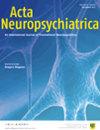The Psychotic Depression Assessment Scale (PDAS) in measurement-based care of patients with psychotic depression.
IF 2.6
4区 医学
Q3 NEUROSCIENCES
引用次数: 0
Abstract
The Hamilton Depression Scale (HAM-D) (1) and the Brief Psychiatric Rating Scale (BPRS) (2) were developed to measure the changes in clinical states resulting from treatment with antidepressant and antipsychotic drugs, respectively. In measurementbased care of depression or schizophrenia the HAMD and the BPRS have been considered as item banks from which short and valid subscales can be derived to increase the responsiveness, for instance, in demonstrating dose–response relationship of antidepressants or antipsychotics (3). The Psychotic Depression Assessment Scale (PDAS) has been developed and validated by Østergaard et al. (4,5) in using the most relevant items from the HAM-D and BPRS banks. Thus, the PDAS contains the six items in the HAM-D6 subscale (6): depression mood, guilt, work and interests, psychomotor retardation, psychic anxiety, and somatic symptoms (tiredness and pains). From BPRS a five-item subscale has been included: hallucinatory behaviour, unusual thought content, suspiciousness, emotional withdrawal, and bunted affect. In this short communication, Köse and Østergaard (7) have evaluated the PDAS when rested in itself by a semi-structured interview. This evaluation has covered the two clinimetric analyses as described by Bech et al. (8), namely both a microanalysis and a macroanalysis. In the microanalysis it is evaluated to what extent the items in the scale fulfil the test of scalability (e.g. the coefficient of homogeneity) for using the total score as a sufficient measure of symptoms severity on the dimension being examined. The macroanalysis is concerned with the standardisation of the total score, for example, when identifying the cut-off score for remission in patients treated for psychotic depression. Köse and Østergaard (7) have demonstrated an acceptable scalability of the PDAS with a coefficient of homogeneity above the level of 0.40, in contrast to the full HAM-D17 or BPRS18. Using a cut-off score of less than 8 on PDAS Köse and Østergaard (7) obtained a remission percentage of 74% at endpoint in their 6 weeks trial including both unipolar and bipolar depressed patients. As most of these psychotic depressed patients have received electroconvulsive therapy (ECT), a remission rate of 74% is in accordance with the classical Medical Research Council (9). In the other classical ECT study, The Northwick Park Electroconvulsive Therapy Trial (10) the superiority of real ECT over simulated ECT in a 4-week treatment period was found in severely depressed patients fulfilling the Newcastle diagnostic scale (11), that is, psychotic depression. The mean HAM-D17 score was in this study at baseline approximately 30 but from this information the degree of psychotic depression is not clear. A score on the PDAS would have been very informative. The Newcastle depression scale is a diagnostic rating scale to predict response to ECT, not a scale measuring the change in the clinical state resulting from treatment with ECT. To the best of my knowledge, we have no other scales than the PDAS for measuring outcomes of treatment for psychotic depression. In measurement-based care of patients with psychotic depression when ECT often is the choice of treatment, the PDAS should be included.精神病性抑郁评定量表(PDAS)在精神病性抑郁患者测量式护理中的应用。
本文章由计算机程序翻译,如有差异,请以英文原文为准。
求助全文
约1分钟内获得全文
求助全文
来源期刊

Acta Neuropsychiatrica
NEUROSCIENCES-PSYCHIATRY
自引率
5.30%
发文量
30
期刊介绍:
Acta Neuropsychiatrica is an international journal focussing on translational neuropsychiatry. It publishes high-quality original research papers and reviews. The Journal''s scope specifically highlights the pathway from discovery to clinical applications, healthcare and global health that can be viewed broadly as the spectrum of work that marks the pathway from discovery to global health.
 求助内容:
求助内容: 应助结果提醒方式:
应助结果提醒方式:


